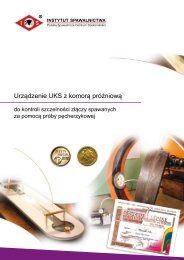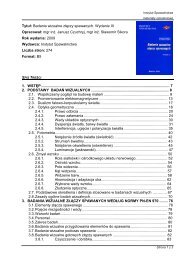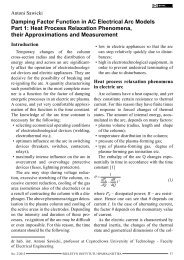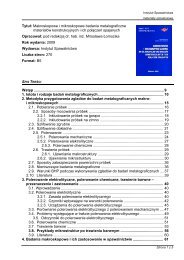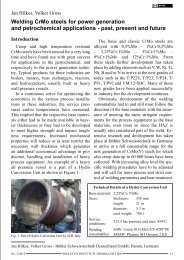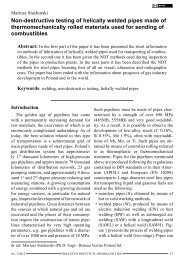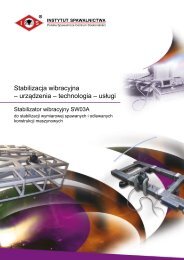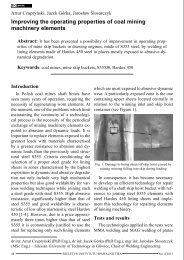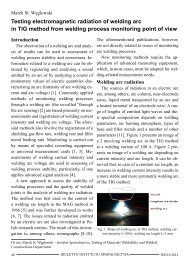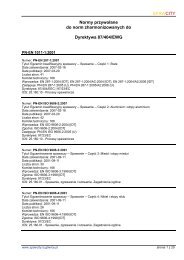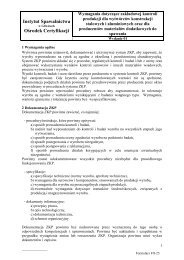Biuletyn Instytutu Spawalnictwa No. 01/2012
Biuletyn Instytutu Spawalnictwa No. 01/2012
Biuletyn Instytutu Spawalnictwa No. 01/2012
Create successful ePaper yourself
Turn your PDF publications into a flip-book with our unique Google optimized e-Paper software.
Antoni Sawicki<br />
Modified Habedank and TWV hybrid models of a variable<br />
length arc for simulating processes in electrical devices<br />
Introduction<br />
The multiplicity, complexity, and problematic<br />
measurability of the characteristics of<br />
processes in arc discharges entails the necessity<br />
of applying various methods of mathematical<br />
description and quantitative analyses.<br />
Numerous physical processes including<br />
electromagnetic, thermal, gasodynamic, and<br />
acoustic as well as the mechanical processes<br />
take place in the plasma and electrodes. The<br />
complexity of such processes results from significant<br />
nonlinearities of static and dynamic<br />
characteristics, collectiveness, and interaction<br />
of plasma components as well as from<br />
the very short relaxation times of the elementary<br />
processes. Difficulties in measurability<br />
are caused by high temperatures, strong heat<br />
(and light) emission, significant gas flow rates,<br />
high quantity gradients in state variables,<br />
very high chemical reaction rates, occasional<br />
difficulties in accessing sensors (including<br />
optical ones) to a discharge area because of its<br />
small size or the fact of being closed. Due to<br />
this and depending on the needs in designing<br />
the power-supply and control systems of elecrotechnological<br />
devices, one adopts various<br />
simplifying assumptions leading to various<br />
degrees of approximation of physicochemical<br />
phenomena using mathematical models. The<br />
simplest and most commonly applied models<br />
include those of Cassie-Berger and Mayr-Kulakov.<br />
However, approximations obtained<br />
using these models are often considered to be<br />
very rough in relation to needs connected with<br />
designing and building various measuring,<br />
supply, and control systems; this being caused<br />
by a necessity to apply various electric excitations<br />
and various conditions of arc burning<br />
in devices. For this reason, various modifications<br />
of equations and new mathematical models<br />
of arcs have been proposed.<br />
Most of the existing arc models (i.e. also<br />
those by Cassie-Berger and Mayr-Kulakov)<br />
take into consideration only one manner of<br />
heat transfer, either conduction or convection,<br />
regarding each of them as dominant in<br />
a variety of technological conditions. The<br />
Cassie-Berger model provides more satisfactory<br />
results in cases when strong currents are<br />
required, whereas the Mayr-Kulakov model is<br />
preferred when weak currents are preferred.<br />
Such an approach to modelling is justified by<br />
an experimentally confirmed assumption, according<br />
to which there is a boundary between<br />
a column of thermal plasma and a turbulent<br />
gas flow around it [1].<br />
The extension of the applicability area of<br />
widely known simplified Cassie-Berger and<br />
Mayr-Kulakov models required the development<br />
of several associations. One of them is<br />
the series connection of two resistances corresponding<br />
to the nonlinear Cassie-Berger and<br />
Mayr-Kulakov models suggested by Habedank.<br />
This combined model, however, lacks<br />
appropriate physical interpretation of phenomena<br />
present in the column. A more rational<br />
solution to the issue of generalisation of description<br />
of processes taking place in the arc<br />
Dr hab. inż. Antoni Sawicki, professor at Częstochowa University of Technology – Częstochowa<br />
University of Technology, Faculty of Electrical Engineering<br />
NR <strong>01</strong>/2<strong>01</strong>2<br />
BIULETYN INSTYTUTU SPAWALNICTWA<br />
15



